A week more spent with Apple’s AirPods Max didn’t do much to change our first impressions. While a great pair of headphones, the lofty $550 price tag means they’re just a bit too out of reach for most consumers.
The who, what and how
Who these are for: If you have a big love for Apple, the latest gadgets or deep pockets you should take a look at AirPods Max. They’re a luxury purchase with refreshing audio, bold active noise cancellation (ANC) and spectacular Spatial Audio for watching movies.
What you need to know: The AirPods Max undoubtedly play in the premium sector of the consumer headphones space. As such, they deliver satisfying sound that hits the right notes, top-notch noise cancellation, best-in-class transparency and a killer home-entertainment audio mode. It’s not all sunshine though: The included case doesn’t make much sense and these really should only be considered if you’re in the Apple ecosystem.
How they compare: Most people will be more than fine with Sony’s WH-1000XM4s (still our pick for over-ear and ANC headphones), and they’re a lot cheaper at $278. Noise canceling is pretty much neck and neck between the two, but AirPods Max are the clear winner with transparency mode. With this mode engaged, it feels like you’re not wearing headphones at all. Apple also gets a win with the materials being used, connectivity, and clear audio that is more refined. Sony includes an actual case and offers 10 more hours of battery life — and they’re half the price.
Comfort formed from top-notch materials
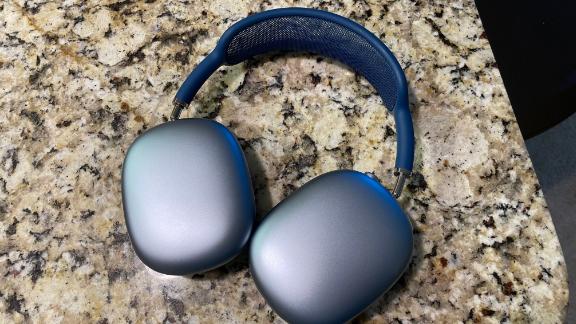
The AirPods Max’s high price tag becomes a bit more reasonable when you understand the materials being used here. AirPods Max feel incredible in your hands and on your head – even if they’re a bit heavy at 384 grams. For comparison, Sony’s WH-1000XM4 are just shy of 255 grams with a plastic build.
Aluminum, stainless steel and the knit band come together for an eye catching design that is comfortable. This type of design is rare in the headphone space, and suggests a level of durability and longevity that justifies the high price. Though keep in mind, these aren’t for working out, as the AirPods Max lack sweat or water resistance.
Each stainless steel ear cup is attached on a pivot system to the arms of the AirPods Max and is easy to adjust.. Since the earcups can sit in a plethora of positions, it allows them to make a seal around the ear with a variety of head shapes. You won’t feel strong pressure from aluminum or stainless steel. The earcups facing your ears are made from a memory foam cushion. This is more malleable than what you’ll see on other headphones and quickly bounces back up.
The AirPods Max has a knit mesh finish that is color-matched and similar to the weave on some Apple Watch bands and smart speakers. It’s quite comfortable on the ear and does a good job containing heat in the cushions, which helps keep your ears from sweating. These are headphones you can wear for quite some time and, dare we say, forget they are on your head a bit.
Moving up from the ear cup is a stainless steel headband which quickly moves into a polyurethane and kinit build. It’s a bit unusual, as normally a headband consists of a top plastic piece with ample cushioning facing the top of your head. Apple’s opted for a knit mesh canopy that is designed to help distribute weight. In our testing, it’s super comfortable by not increasing weight on the top of your head. And properly splits the weight between the left and right ear cups.
The real clutch feature of the design is that the cushion portion of the earcups are attached magnetically. With a little tug you can pop them off for proper cleaning and if they get worn down after a few years, Apple does sell replacements for a steep $69. Still, it’s a novel feature as no other consumer-grade headphones offer this. The cushions will likely get worn down and dirty the fastest.
The outside of the ear cups also contains many cutouts — both for vents and microphones. There are nine total microphones on AirPods Max for noise cancellation and other use cases. The right ear cup is a bit more packed with a Lightning port and LED indicator, an action button and the Digital Crown. It’s command central for controls.
Controlling AirPods Max is a distinctly different experience. Most headphones opt for touch controls on the ear cups or buttons on the bottom side of the cup. AirPods don’t do either of those – there are two inputs and they’re on the top of the right earcup. The Digital Crown – the same dial made famous by the Apple Watch – is here and enlarged. You’ll turn it to adjust volume, click it to play or pause, double click to move forward, triple-click to go back and long press to engage Siri. For the latter, though you can just say “Hey Siri” as it’s cooler and faster. The action button faces … well your face, and allows for quick switching between active noise cancellation or transparency modes.
And while it took about 24 hours to get used to the controls – we’ve found them both intuitive and more precise over the touch controls. We haven’t had accidental touches and don’t struggle with remembering where to swipe on the earcup. And in the winter you won’t be struggling while wearing gloves or have moisture on the cups engage commands. You can also control the experience via the connected device.
The case just doesn’t make sense
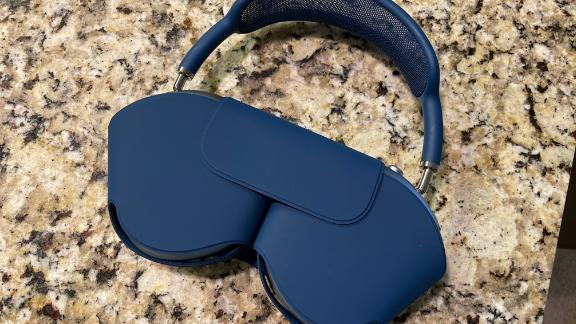
It’s not all perfect here though, and that’s to be expected for a first-generation product. We can’t really wrap our heads around the case for AirPods Max. Apple calls it a Smart Case and it has one neat trick but doesn’t really do what a case should.
A case should wrap around a product and provide protection. For a pair of headphones, you don’t even need a cutout on it for control. Apple didn’t do this and instead released a pretty flimsy case with magnets inside. It protects the ear cups and nothing else. It’s a polyurethane material like a Smart Cover for an iPad and has a velvet-like lining. It doesn’t protect against drops and doesn’t even fully wrap around the lower parts of the AirPods Max. The stainless steel headband and knit mesh top are all out in the open. In fact, that headband is the handle when using the case. It’s like a mini purse.
It’s just not a good case and doesn’t set out to do what a case should. The only pro here is placing the AirPods Max in the case puts them in a low-power mode which is essentially the closest thing to turning these over-ear cans off. There is no power button on the AirPods Max, but in this state, it conserves battery and offers a steady length for standby. You can also charge AirPods Max with a Lightning cable while it’s in the case.
But wouldn’t it be amazing if these worked with MagSafe for wireless charging or even if the included case recharged the AirPods Max? We have high hopes for generation two and are equally excited for third-party cases. Nomad, Incipio and Otterbox – we’re looking at you.
This one doesn’t bother us as much, but you can’t fold or collapse AirPods Max down. They’re stuck in the same state except for ear cups that can rotate. The case is just downright weird.
Sound is both refreshing and satisfying
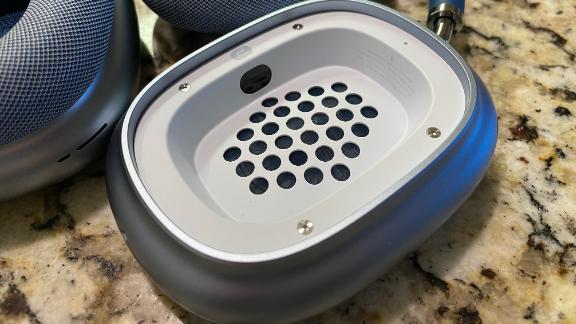
At $550, the AirPods Max have to sound good. We’re happy to report that the headphones’ sound is terrific – both refreshing and satisfying at the same time. It’s a vibrant mix, similar to that of the AirPods Pro, with more breadth and depth that shines with clear instrument separation and a wide soundstage. On bass specifically, it’s a roaring thump that can get a bit deeper when needed while also not over-emphasizing those tones. We also didn’t experience any distortion or crackling at any volume – be it 30%, 65% or 100%.
Powering the audio experience is a pair of 40-millimeter drivers — one in each ear cup. And inside those are two neodymium ring magnet motors that physically move to create the sound. Apple uses computational audio known as Adaptive EQ to mix the sound on the fly for your ears. It’s listening, via a microphone, to hear how the mix sounds and to adjust. This results in a balanced mix that allows for vibrant pops of sound and lower tones that provide grounding for the track.
You won’t find a custom EQ mixer on AirPods Max like Sony offers on the WH-1000XM4. We’d also say that while the bass is strong here, AirPods Max dont push out as thunderous of a deep tone as the XM4 do.
It’s ultimately very close – suffice to say AirPods Max and Sony WH-1000XM4 both deliver a great sound experience. AirPods Max perform a lick or two better with the soundstage, as you clearly hear each instrument and the mix gives each of them room to breathe. For instance with a crowded track like “Ghosts” by Bruce Springsteen, you can clearly make out the guitars, piano, organ and drums. It’s pretty remarkable that the AirPods Max can separate out each instrument, even when they’re building to a climactic wall of sound. There was no distortion or crackling at any volumes as well. On Sony’s WH-1000XM4, things sounded a bit more muddied and less clear. Though the drums have a bit more of a snap to them and you can adjust the mix on the fly with an equalizer.
“Exile” by Taylor Swift is a great way to hear the soundstage and the separation of instruments. AirPods Max were able to deliver Bon Iver’s vocals in a deep fashion that doesn’t overshadow the higher piano tones. It also avoids any tinning or unintended sparks which can sometimes occur in headphones. It’s just presented as polished as you would expect.
“Bury a friend” by Billie Eilish shows how AirPods Max can differentiate lower tones with a high amount of clarity. As we’ve seen on Beats and, to some degree, the WH-1000XM4s, lower tones can lose some clarity and generate reverb. AirPods Max presents them with clarity while also providing the intended buzzing effect that the tones on this track leaves. It’s an enjoyable mix and the bass is very tight with excellent depth.
AirPods Max can also get loud, but we didn’t find ourselves reaching to increase volumes. Most listening sessions during our testing were around the 60%-75% volume mark, and we experienced good tones and clarity at those volumes.
Noise canceling is top-notch, while transparency sets a new standard
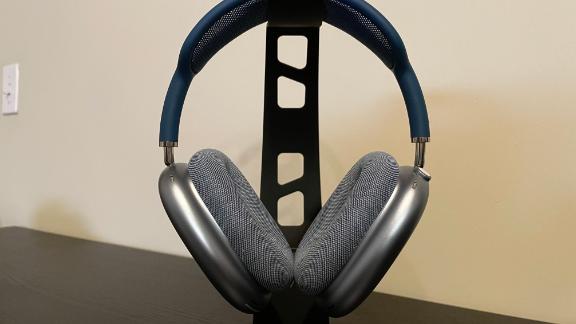
As we said in our first impressions, ANC (active noise canceling) on AirPods Max perform neck-and-neck with the class-leading Sony WH-1000XM4. They’re our top pick for over-ear and ANC headphones. We still stand by that – the WH-1000XM4 and AirPods Max offer the best noise cancellation currently on the market.
Since we tested those Sony cans in the pandemic as well, we ran those same tests (blocking out HVAC, generated crowd or environmental sounds via speakers, walking around town – with masks and social distancing – and transit) on the AirPods Max. The biggest difference is AirPods Max have just one mode and it’s active noise cancellation. With it engaged, like on AirPods Pro, it blocks out the world around you to an incredibly effective degree. Sony’s WH-1000XM4 gives you multiple levels to play with and to some degree, Apple’s approach is easier. It’s just a turn on and go focus.
It’s really quite effective and it’s an experience that is powered by the passive seal of the earcups and the active use of nine microphones. The two Apple H1 processors inside work together to block out the noise and just present you with a slight hiss – and the emptiness of sound. At times it’s slightly better than the Sony’s, but ultimately we’re splitting incredibly fine hairs.
With no music or audio being played back, the AirPods Max can cut on an HVAC vent. And next to the main blower set too high, it brings it down to an effective cool wisp. Standing on a platform as trains came from either side resulted in no sound with music playing and it also compensated for wind outside. This is top-notch noise canceling.
The real star is transparency mode, which essentially brings in the world around you in a very natural way. There’s no extra processing or graininess being introduced. You can clearly make out speech, either pre-recorded or from actual humans, a dog barking or a knock on the door.
The sensors on the AirPods Max also allow for an easy transition from wearing to having them off. As soon as you lift an ear cup or take the headphones off, playback is paused and you’re back in the real world. You can also get a seamless transition between all your Apple devices. And placing them back on reconnects to the device you’re using and it can resume playback. It’s the AirPods experience you’d expect.
Spatial Audio delivers and presents big potential

Even after a week of listening to full albums, streaming shows, engaging in thoughtful podcasts, taking calls and watching movies – Spatial Audio still stands out as a strong spot. Essentially, it’s Apple’s tech for placing sound around you. It works with 5.1, 7.1 and Dolby Atmos content, and is essentially a home theater for your head. It’s exclusive to AirPods Max and AirPods Pro as well.
Spatial Audio is a wider and more immersive experience compared to normal content consumption on other headphones. As we tested in our first impressions with an episode of “The Mandalorian,” objects like the Razor Crest or Slave-1 have locations to them. If it’s zooming past you on the screen right past Moff Gideon, you’ll hear it on the left side.
This experience works with accelerometers and gyroscopes inside the AirPods Max, but also requires those same sensors on the connected device. That means it is limited to an iPhone or iPad. As if your head is facing away from the screen, it places the audio in the proper space around you. We thoroughly enjoyed it in action movies filled with superheroes, galactic villains and even in Hamilton.
It’s really neat but we want to see this on the big screen and right now the current Apple TV doesn’t support Spatial Audio. We’re really hopeful that a future model will support this to make the big screen experience even more impressive.
Last but not least: Battery life and microphones
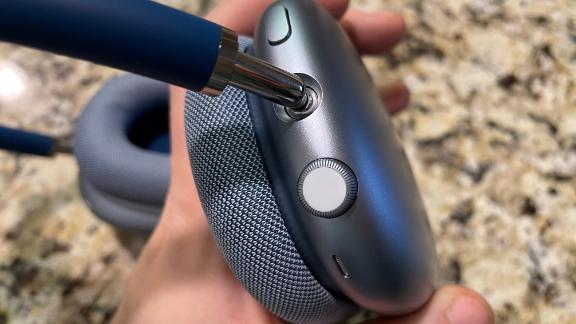
Apple promises 20 hours of use on the AirPods Max with noise cancellation engaged and that’s where we fell. In our sustained battery test with volume at 50% we stretched that to 21 hours, but in everyday use with volume fluctuating and switching between different modes we fell closer to 19 to 20 hours.
That’s still commendable, but it does fall behind the 30 hours of the Sony WH-1000XM4. It’s not class-leading, but it’s enough for most use-cases and for whenever we can travel via airplanes again in the future.
AirPods Max does support fast charging as well. Plugging them in for five minutes will deliver about an hour and a half of playback with noise-canceling engaged.
Equally as important as battery life is the ability to use AirPods Max for communication. And out of those nine microphones on these cans, three are dedicated to voice pickup and for the most part deliver clear speech pickup. We did encounter one issue with a Webex call in which the volume was coming out very low and a bit garbled. In fact, it seemed that audio fully stopped being picked up by AirPods Max and when it did come through those on the other end couldn’t make out what was being said. Not a good experience.
Other VoIP calls including FaceTimes did perform more clearly. Phone calls over LTE or Wi-Fi calling were strong as well. We think AirPods Max are on par with Sony’s WH-1000XM4, similar to AirPods Pro, but with marginally more skills at removing wind. That’s a common issue with over-ear headphones and a struggle that users can attest to. At times, AirPods Max did make us sound a little more sharp and jagged. We’re eager to try these on an airplane or mass transit once it is safe to do so.
AirPods Max were quick to pick up “Hey Siri” commands and message transcription is about on par with the iPhone itself or AirPods Pro. You can hear some samples below recorded with Voice Memos on connected iOS devices.
Bottom Line
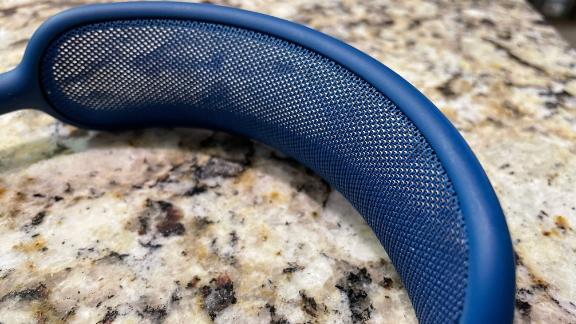
AirPods Max are a really great pair of headphones with some bright spots – a high-end luxurious design, satisfying sound that is polished, strong connectivity within the Apple ecosystem and a triple threat with noise cancellation, transparency and spatial audio.
The case is leaving us baffled and the price is still high – though it makes more sense now that we’ve used Apple’s headphones for a few weeks. Battery life could be longer and we’d like to see some more innovation with how you can charge it.
Music playback is seriously enjoyable, but largely in line with Sony’s WH-100XM4. Same with noise canceling – they’re both top notch. Transparency mode shoots into the stratosphere with an experience that feels like you’re not wearing headphones. We love the comfort of the design and the materials being used. The controls, while very different, are intuitive. And Spatial Audio feels like it’s going to be even better when it enters the home entertainment space.
AirPods Max at $550 are a luxury purchase, but they may be worth it depending on what you’re looking for. If you want a pair of terrific over-ear headphones, opt for the Sony WH-1000XM4. For most of you, those will be the perfect choice and are just $278. If you want to take it to the next-level and have the budget, AirPods Max deserve a look and sit as our luxury pick. Just don’t pay the wild amount that people are reselling them for on eBay.
"Max" - Google News
December 18, 2020 at 06:00AM
https://ift.tt/2Wn4jZQ
AirPods Max Review: The Price You Pay - CNN
"Max" - Google News
https://ift.tt/2YlVjXi
Bagikan Berita Ini
















0 Response to "AirPods Max Review: The Price You Pay - CNN"
Post a Comment